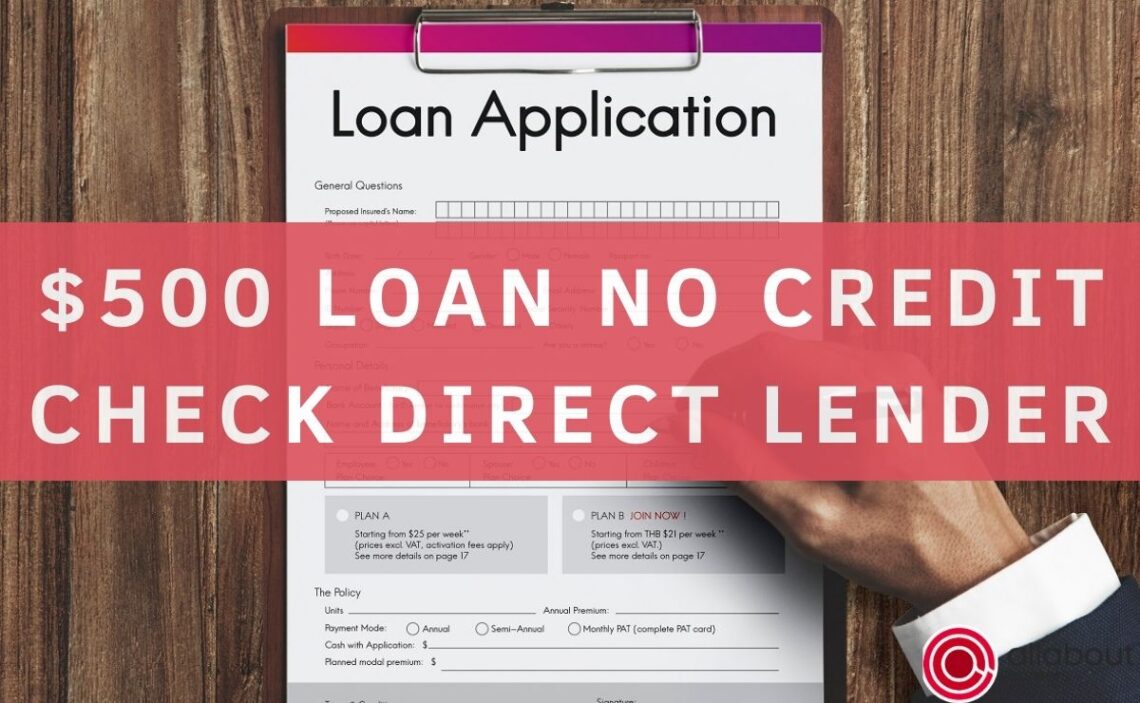$500 Loan No Credit Check Direct Lender Bad Credit

In an era defined by economic uncertainty, many Americans find themselves caught in a financial bind, desperately seeking small loans to bridge income gaps or cover unexpected expenses. The allure of a quick fix, such as a "$500 Loan No Credit Check Direct Lender Bad Credit," can be incredibly tempting, especially for those with tarnished credit histories. However, these seemingly easy solutions often come with significant risks and hidden costs that borrowers must understand.
This article delves into the world of no-credit-check loans, exploring their appeal, the potential dangers they pose, and the alternative options available to individuals facing financial hardship. We will examine the perspectives of both lenders and borrowers, drawing on expert insights and data to provide a comprehensive overview of this complex financial landscape. The goal is to equip readers with the knowledge necessary to make informed decisions and avoid falling prey to predatory lending practices.
The Appeal of No-Credit-Check Loans
The primary draw of "$500 Loan No Credit Check" options lies in their accessibility. Traditional lenders rely heavily on credit scores to assess risk, automatically disqualifying individuals with poor or limited credit histories.
No-credit-check lenders, on the other hand, often market themselves as providing a lifeline to those underserved by mainstream financial institutions, promising quick approval and minimal paperwork.
Who Uses These Loans?
These loans frequently attract individuals facing emergency expenses like medical bills, car repairs, or unexpected home repairs. They are also used by those struggling to make ends meet between paychecks. This demographic often includes low-income workers, self-employed individuals, and those with limited access to traditional financial services.
A 2023 report by the Financial Health Network indicates that a significant portion of Americans struggle with financial insecurity, making them vulnerable to predatory lending practices. This vulnerability is exacerbated by a lack of financial literacy and limited access to affordable credit options.
The Dark Side: High Costs and Hidden Fees
While no-credit-check loans offer immediate relief, they typically come at a steep price. These lenders often compensate for the increased risk by charging exorbitant interest rates and fees, potentially trapping borrowers in a cycle of debt. Annual Percentage Rates (APRs) can soar into the triple digits, far exceeding those of traditional loans or credit cards.
Furthermore, some lenders may impose hidden fees, such as origination fees, late payment penalties, and prepayment penalties, further increasing the overall cost of the loan. The Center for Responsible Lending has consistently highlighted the dangers of these high-cost loans, emphasizing their disproportionate impact on vulnerable populations.
Predatory Lending Practices
The lack of credit checks can also enable predatory lending practices. These practices often involve lenders targeting vulnerable borrowers with deceptive marketing tactics and unclear loan terms. Some lenders may fail to adequately disclose the true cost of the loan or engage in aggressive collection practices, further exacerbating the borrower's financial distress.
"Borrowers need to be incredibly cautious when considering no-credit-check loans," warns Sarah Bloom Raskin, former Deputy Secretary of the Treasury. "The promise of quick cash should not blind them to the potential for long-term financial harm."
Direct Lenders vs. Loan Brokers
It's crucial to distinguish between direct lenders and loan brokers. Direct lenders fund the loans themselves, while brokers act as intermediaries, connecting borrowers with potential lenders.
While brokers can offer access to a wider range of options, they may also charge fees for their services, adding to the overall cost. Direct lenders, on the other hand, may have more straightforward terms and conditions, but it's essential to compare offers from multiple sources to ensure you're getting the best possible deal.
The Role of Online Platforms
The rise of online lending platforms has made it easier for borrowers to access no-credit-check loans, but it has also increased the risk of encountering fraudulent or unscrupulous lenders. Borrowers should carefully research any lender before applying for a loan, checking their credentials and reading online reviews. They should also be wary of lenders who request upfront fees or pressure them to borrow more than they need.
Alternative Options to Consider
Before resorting to a "$500 Loan No Credit Check Direct Lender," borrowers should explore alternative options that may be more affordable and sustainable. These include:
- Credit Counseling: Non-profit credit counseling agencies can provide free or low-cost financial advice and assistance.
- Payday Loan Alternatives (PALs): Credit unions offer PALs, which are small-dollar loans with lower interest rates and fees than payday loans.
- Personal Loans from Community Banks: Local community banks may be more willing to work with borrowers who have imperfect credit.
- Borrowing from Friends or Family: While potentially awkward, borrowing from loved ones can be a more affordable and flexible option.
- Negotiating with Creditors: Borrowers may be able to negotiate payment plans or reduced interest rates with their existing creditors.
Building or Repairing Credit
Long-term, the best way to avoid the need for no-credit-check loans is to build or repair your credit. This can be achieved by paying bills on time, reducing debt, and obtaining a secured credit card. Experian, Equifax, and TransUnion all offer free credit reports annually.
The Regulatory Landscape
The regulation of no-credit-check loans varies by state, with some states imposing strict limits on interest rates and fees, while others have little or no regulation. The Consumer Financial Protection Bureau (CFPB) has been working to crack down on predatory lending practices, but more needs to be done to protect consumers from these harmful products.
It's important for borrowers to be aware of their rights and to report any suspected violations to the appropriate regulatory agencies.
Looking Ahead
The demand for small-dollar loans is likely to persist, particularly among those with limited access to traditional credit. However, it is crucial to promote responsible lending practices and provide borrowers with access to affordable and sustainable alternatives. This requires a multi-pronged approach, involving stronger regulation, increased financial literacy, and the development of innovative financial products that meet the needs of underserved communities.
Ultimately, the goal is to empower individuals to make informed financial decisions and avoid falling into debt traps that can have devastating consequences. Informed consumers are less vulnerable to predatory practices, and understanding the full cost and risk associated with "$500 Loan No Credit Check Direct Lender Bad Credit" options is the first step toward securing financial stability.




